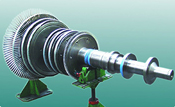OUR LOCATIONS
We can provide our services to power plants worldwide
Bradenton, Florida
941 - 527 - 6196
941 - 755 - 5229 (FAX)
Milwaukee, Wisconsin
414 - 698 - 5644
|

LOW SPEED SHOP BALANCING
Low-speed balancing is necessary in some cases, particularly when a rotor cannot fit in an available high-speed balancing bunker (such as a very large LP turbine), or when the expenditure/time required for a high-speed balance simply isn’t available. In the case of more rigid turbine rotors with minimal eccentricity (within ISO 1940 standards), it can be a preferred and efficient alternative to high speed balancing.
One new and particularly valuable application of Z-R Consulting’s 2N+1 balancing method is the ability to balance highly flexible generator rotors (such as for nuclear power plants) on-site on a low-speed balancing machine or lathe, while still providing a strong guarantee of a smooth restart. This allows a generator rotor overhaul or rewind to be performed entirely on site, saving substantial time and cost.
On a low-speed balancing machine, since a rotor never runs fast enough to dynamically bend, the balance procedure is also referred to as rigid-body balancing. Low-speed balancing can be performed on machines having hard (rigid) or soft (flexible) journal supports.
If a rotor has significant mass eccentricity, it is preferable to perform low-speed balancing on a machine with hard journal supports. On soft-bearing machines, the total system stiffness is very low, and a rotor will pass through the first system critical speed at a very low rpm. Recall that a rotor switches its axis of rotation while passing through the first system critical, from its geometric axis to its mean mass axis. Therefore, for eccentric/bowed rotors, any balancing performed above the first critical balances the rotor around its mass axis, even though its rotation will be constrained to its geometric axis by adjacent rotors when installed. Only if rotor eccentricity is low (< ~ 0.003 inches), is balancing on a machine with soft supports appropriate.
Regardless of whether low-speed balancing is performed using a soft or hard bearing machine, it is recommended to place correction weights following the 2N+1 balancing method, which means balancing in a minimum of 3 balancing planes. This ensures that the rotor is balanced around its geometric axis, and that it will run smoothly upon reinstallation. If a turbine rotor only has two balancing planes (endplanes), and has measured eccentricity above ~ 0.002”, a third middle plane must be machined in (boltholes or groove). If adding a third plane is not possible (due to thermal or material conditions), then balancing cannot be properly performed, and the rotor must be machined to shift the journal centers.
|